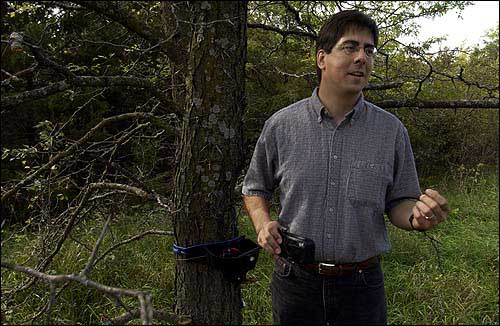Big game on campus
Photo shows 'proof' of mountain lion

Wildlife experts say the image of a mountain lion can be seen in this patch of grass on Kansas University's west campus. The photo was taken by a motion detection-triggered wildlife camera last week.
If you’re hiking on Kansas University’s west campus, don’t drag a deer carcass with you. And, for heaven’s sake, don’t make any noises resembling a wounded rabbit.
A suspected mountain lion that has been seen skulking through the wooded terrain of west campus has apparently shown up again — and there’s photographic proof.
“I think this is going to go off like a bomb,” said Mark Jakubauskas, a KU faculty member who claims to have caught the beast on film. “Having actual photographic proof is pretty cool.”
Jakubauskas, a research assistant professor for the Kansas Applied Remote Sensing Program with the Kansas Biological Survey, has been seeking photographic proof of a mountain lion since August.
Though mountain lions have been confirmed in Missouri and Nebraska — and despite dozens of witness reports in Kansas — state wildlife officials have been resolute in denying the big cats exist in Kansas.
Jakubauskas, keen to prove otherwise, has been doing his big-game hunting with a motion detection-triggered wildlife camera.
He set up the camera in a wooded area on west campus after reports in August in the Journal-World, 6News and World Online that a mountain lion was seen in the past year by several people in that area.
Jakubauskas kept a low profile about his hunt — he said he didn’t want to raise expectations.
Neither did he want anyone to disturb the camera. He told only a co-worker and the associate director at the biological survey of his plans. He also told the Journal-World, which photographed him placing his camera.
“This is way outside my normal work,” Jakubauskas said. “Normally I do all my remote sensing from satellite and aerial photography.”
After setting up the camera, he checked it every 10 days to two weeks or so.
It was set up to take a flash photograph in the twilight or at night — when mountain lions typically move about.
In the past few weeks, he captured photos of several deer and a raccoon.
Though he just discovered it Tuesday, the photo Jakubauskas thinks is of a mountain lion probably was shot Oct. 1, he said.
Second opinions
Jakubauskas e-mailed the photo to several people to get their opinions, including a friend who is a vertebrate ecologist and mammalogist — Michael Shaughnessy, an assistant professor of biology at Morehead State University in Kentucky.
“That is almost certainly the mountain lion,” Shaughnessy replied. “The giveaway is the size in comparison to the grasses. Notice particularly how the belly clears the 20- 30-centimeter grasses. That puts the animal higher than a bobcat.
“Additionally, the tail with the dark tip is diagnostic of mountain lions. The relative size puts it above house cats compared to the grasses, and on the off chance you had a Canada lynx — you don’t; the lynx has a stub of a tail and is spotted. It isn’t a dog — the tail is too vermiform.”
Jakubauskas sent the image to others to get their opinions, but he hadn’t received other responses by Tuesday evening.
Chad Luce, public information officer with Kansas Department of Wildlife & Parks, said most sightings turned out to be other animals or escaped exotic pets.
Luce showed Jakubauskas’ photo to Wildlife & Parks experts who have been studying mountain lion sightings.
They told him the photo was inconclusive and could be a coyote or a gray fox. Efforts to contact those experts late Tuesday were unsuccessful.
Luce, who doesn’t claim to be an expert, admitted he didn’t know what the animal in the photograph was.
“When I first saw the large picture, I thought it was a dog, a chow,” Luce said. “Then when I looked at the tail, I hesitated because it didn’t look dog-like.”
Leave it alone

Mark Jakubauskas, research assistant professor in the Kansas Applied Remote Sensing Program of the Kansas Biological Survey at Kansas University, talks about trying to capture a picture of a mountain lion on KU's west campus. Jakubauskas believes the image he captured Oct. 1 is of a mountain lion.
Jakubauskas said he thought the mountain lion should be left alone instead of captured.
“It apparently hasn’t posed a hazard to anybody,” he said. “House pets haven’t been disappearing, like other stories out on the Colorado front range, where domestic pets have been disappearing from the suburbs and joggers have been attacked.
“From what I’ve heard, there haven’t been any reports like that around here,” Jakubauskas said, “so I’d say until the thing presents a nuisance, it’s doing all right by itself making a living.”
Mountain lions, also known as cougars, were once native to Kansas but were eliminated by hunting and habitat destruction. After a mountain lion was struck during August on a Missouri highway, though, Dave Hamilton, a biologist with the Missouri Conservation Department, said the wild mountain lions may be migrating from South Dakota, Colorado or Texas.








